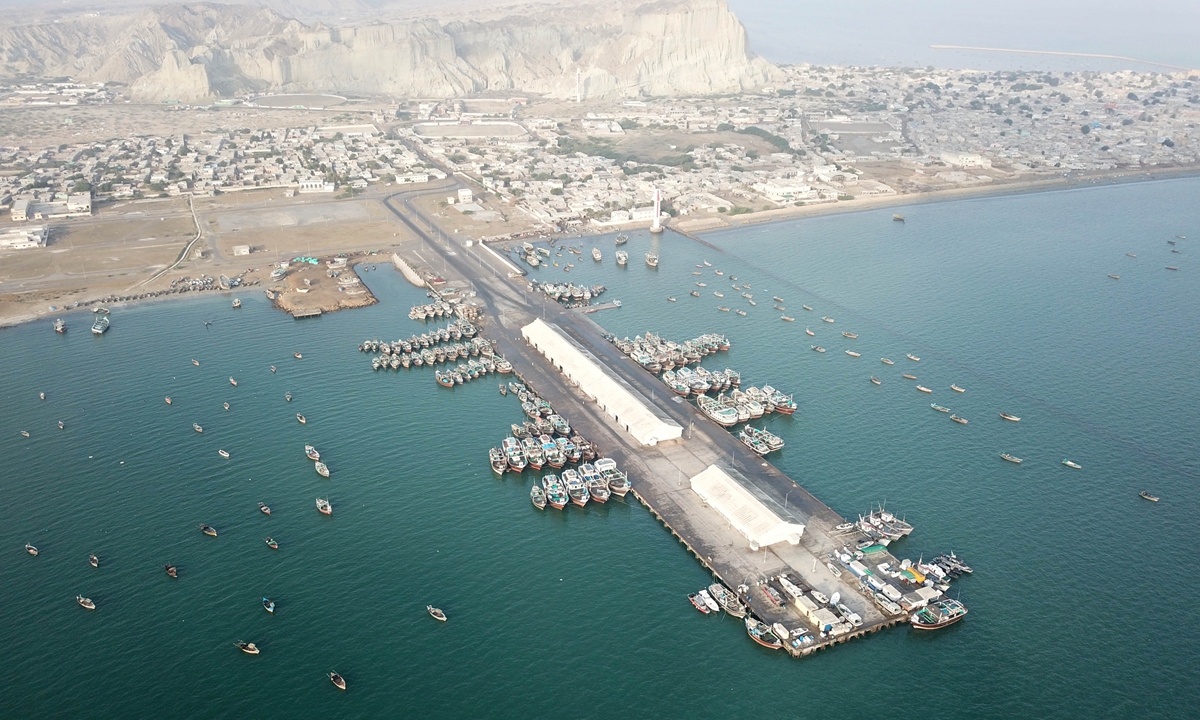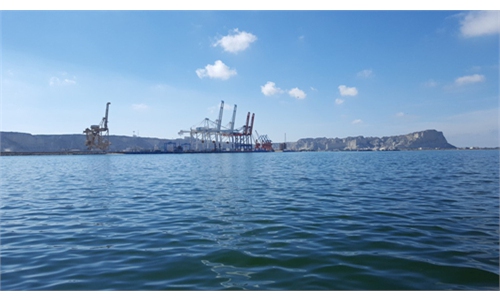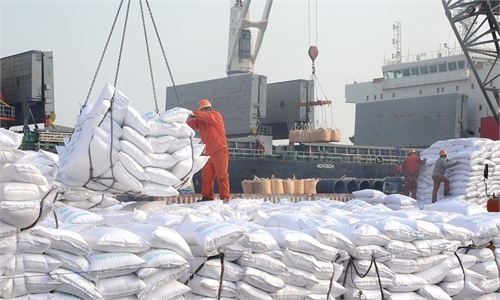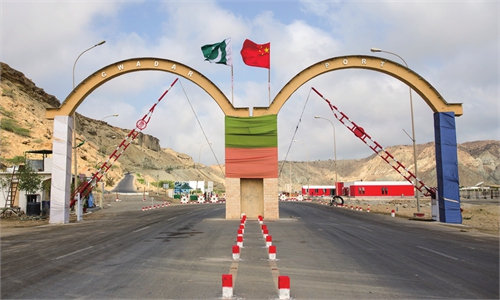
Gwadar Port in Southwestern Pakistan on January 29, 2018 Photo: Xinhua
Gwadar Port, the center of monumental attraction in the Pakistan-China relations, is up and running weathering all odds gradually. However, a new challenge is now surfacing. It is about the unrealistic public perception and delusion regarding its development timeframe and its trickledown effects to the local people in such a short span of time.
Since the Chinese company China Overseas Ports Holding Company (COPHC) in cooperation with Gwadar Port Authority (GPA), and other government departments started managing Gwadar Port in 2015 with aims to make Gwadar an economic and logistic hub that has the potential to generate $10 billion in GDP for Pakistan's economy, the local people pinned lofty expectations that Gwadar, a small fishing town, was set to explode in one or two years. Listening to mega development projects with massive investment flow and enormous job opportunities, they plunged into the pipe dream that all their poverty related woes were going to end forthwith.
The reality of the matter is that positive changes to the lives of the local people have been taking place even more convincingly during the last three years despite two years of a global pandemic but people far more credulously focus on anticipated miracles, which, of course, is not the job of development.
During my most recent Gwadar trip when I interacted with local communities as well as officials, one issue also came to the surface that some fault line also lies within the government's strategy that seems to have played some role in allowing the people of Gwadar to harbor illusions not supported by reality.
Whenever projects were launched or announced, with millions or billions of dollars worth of investment plans, a massive hype is created. For example, in the establishment of the $500 million first phase of the Gwadar Free Zone on a 60-acre piece of land, other game-changing development projects have also been completed. Required Infrastructure including access roads, internal roads, business centers, water, gas, power, warehouses, and repair yards, custom facilities, various government offices, and other allied facilities have come into operation. Six factories are currently operational and 12 more are under construction. Gwadar harbor has been revamped. It also includes a livestock farm and the Women Development Employment Center (WDEC), and a greenhouse, all of which are producing remarkable results. 46 companies are already registered gearing up to pump heavy investment into an export-oriented industry.
The GPA has also completed grueling works including the completion of the zirbar and gurab commercial complexes, the seamen center, a container freight station, a cargo shed, a marine repair yard shed, a container repair yard shed, the Pakistan-China friendship road, and a container staking area.
"Instead of showcasing all these legendary works in a balanced way, to somehow display a distorted image entrenches the perception that Gwadar people's predicaments regarding poverty, business, education, health, and other such issues are set to disappear quickly and that access to basic amenities and a guaranteed brighter future will be almost instantaneous. Development projects have their own flow of impacts, so local people did not witness what they had envisioned," GPA official told me.
"It is fair enough to say that the people of Gwadar hold no grudge against China, China-led developments, and Chinese companies and people. What requires to be done is to keep them away from the illusion of smoke and mirrors," local businessman Jalal Baloch said.
During the tour, I interviewed Gwadar protest sit-in supreme leader Maulana Hadayat Ur Rehman during such a sit-in procession. In response to a question, Maulana categorically said, "[The] Gwadar protest is never against China and CPEC shrugging off Western-propelled venomous propaganda."
"We want respect, development, and basic amenities as enshrined in the constitution of Pakistan," he added.
Frankly speaking, it is high time for all those concerned to get a reality check. There are actually many success stories that have been realized in Gwadar with the arduousness of COPHC chairman Zhang Baozhong and GPA chairman Naseer Ahmed Kashani.
In terms of employment, the livestock goat farm in the Gwadar free zone recruited local people. In an interview, Dil Jan Khalid Raheem Buksh, Muhammad Younas, and Abdul Jaleel said that through fishing alone, it had been difficult to make both ends meet. "Since we are employed here, [our] financial situation has improved," they added.
Balqees Iqal, who works as a seamstress in the WDEC, said that in her previous job, she had to contend with low wages, delayed payments, or unemployment for certain periods of time. In Gwadar Free Zone where WDEC is located, she said that she had job security and a reasonable salary, enough to run her kitchen.
Besides this, it is important to showcase development projects integral to the direct development of the local people. Fishing, for instance, required direct access to the sea which was hampered by the Eastbay Expressway.
In addressing such grievances, the GPA redesigned the Eastbay Expressway and as a result one overhead bridge was constructed allowing local fishermen to carry their boats beneath the bridge to the sea to earn their livelihood, GPA Chairman Naseer Ahmed Kashani said. Two more overhead bridges are under construction to offer more access, he added. The Eastbay Expressway meant to connect Gwadar port to Hoshab (M-8) for the swift conduction of traffic is almost 95 percent complete, he added.
The author is founder and president of the Institute of International Relations and Media Research in Pakistan. opinion@globaltimes.com.cn

Gwadar Port in Southwestern Pakistan on January 29, 2018 Photo: Xinhua
Gwadar Port, the center of monumental attraction in the Pakistan-China relations, is up and running weathering all odds gradually. However, a new challenge is now surfacing. It is about the unrealistic public perception and delusion regarding its development timeframe and its trickledown effects to the local people in such a short span of time.
Since the Chinese company China Overseas Ports Holding Company (COPHC) in cooperation with Gwadar Port Authority (GPA), and other government departments started managing Gwadar Port in 2015 with aims to make Gwadar an economic and logistic hub that has the potential to generate $10 billion in GDP for Pakistan's economy, the local people pinned lofty expectations that Gwadar, a small fishing town, was set to explode in one or two years. Listening to mega development projects with massive investment flow and enormous job opportunities, they plunged into the pipe dream that all their poverty related woes were going to end forthwith.
The reality of the matter is that positive changes to the lives of the local people have been taking place even more convincingly during the last three years despite two years of a global pandemic but people far more credulously focus on anticipated miracles, which, of course, is not the job of development.
During my most recent Gwadar trip when I interacted with local communities as well as officials, one issue also came to the surface that some fault line also lies within the government's strategy that seems to have played some role in allowing the people of Gwadar to harbor illusions not supported by reality.
Whenever projects were launched or announced, with millions or billions of dollars worth of investment plans, a massive hype is created. For example, in the establishment of the $500 million first phase of the Gwadar Free Zone on a 60-acre piece of land, other game-changing development projects have also been completed. Required Infrastructure including access roads, internal roads, business centers, water, gas, power, warehouses, and repair yards, custom facilities, various government offices, and other allied facilities have come into operation. Six factories are currently operational and 12 more are under construction. Gwadar harbor has been revamped. It also includes a livestock farm and the Women Development Employment Center (WDEC), and a greenhouse, all of which are producing remarkable results. 46 companies are already registered gearing up to pump heavy investment into an export-oriented industry.
The GPA has also completed grueling works including the completion of the zirbar and gurab commercial complexes, the seamen center, a container freight station, a cargo shed, a marine repair yard shed, a container repair yard shed, the Pakistan-China friendship road, and a container staking area.
"Instead of showcasing all these legendary works in a balanced way, to somehow display a distorted image entrenches the perception that Gwadar people's predicaments regarding poverty, business, education, health, and other such issues are set to disappear quickly and that access to basic amenities and a guaranteed brighter future will be almost instantaneous. Development projects have their own flow of impacts, so local people did not witness what they had envisioned," GPA official told me.
"It is fair enough to say that the people of Gwadar hold no grudge against China, China-led developments, and Chinese companies and people. What requires to be done is to keep them away from the illusion of smoke and mirrors," local businessman Jalal Baloch said.
During the tour, I interviewed Gwadar protest sit-in supreme leader Maulana Hadayat Ur Rehman during such a sit-in procession. In response to a question, Maulana categorically said, "[The] Gwadar protest is never against China and CPEC shrugging off Western-propelled venomous propaganda."
"We want respect, development, and basic amenities as enshrined in the constitution of Pakistan," he added.
Frankly speaking, it is high time for all those concerned to get a reality check. There are actually many success stories that have been realized in Gwadar with the arduousness of COPHC chairman Zhang Baozhong and GPA chairman Naseer Ahmed Kashani.
In terms of employment, the livestock goat farm in the Gwadar free zone recruited local people. In an interview, Dil Jan Khalid Raheem Buksh, Muhammad Younas, and Abdul Jaleel said that through fishing alone, it had been difficult to make both ends meet. "Since we are employed here, [our] financial situation has improved," they added.
Balqees Iqal, who works as a seamstress in the WDEC, said that in her previous job, she had to contend with low wages, delayed payments, or unemployment for certain periods of time. In Gwadar Free Zone where WDEC is located, she said that she had job security and a reasonable salary, enough to run her kitchen.
Besides this, it is important to showcase development projects integral to the direct development of the local people. Fishing, for instance, required direct access to the sea which was hampered by the Eastbay Expressway.
In addressing such grievances, the GPA redesigned the Eastbay Expressway and as a result one overhead bridge was constructed allowing local fishermen to carry their boats beneath the bridge to the sea to earn their livelihood, GPA Chairman Naseer Ahmed Kashani said. Two more overhead bridges are under construction to offer more access, he added. The Eastbay Expressway meant to connect Gwadar port to Hoshab (M-8) for the swift conduction of traffic is almost 95 percent complete, he added.
The author is founder and president of the Institute of International Relations and Media Research in Pakistan. opinion@globaltimes.com.cn



